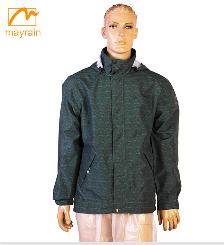 rainwears@163.com may@may-rain.com
rainwears@163.com may@may-rain.com Mon to Friday: 8.00 am - 7.00 pm
Mon to Friday: 8.00 am - 7.00 pm
Choosing The Right Women's Windbreaker Raincoat For Outdoor Adventures
For women who love outdoor activities, finding the perfect women's windbreaker raincoat is essential. Whether you're trekking through forests, biking in the rain, or commuting in unpredictable weather, a versatile windbreaker with waterproof functionality ensures you stay dry and comfortable. These coats combine practicality with a flattering silhouette, offering lightweight protection without compromising on style.
Urban commuters often deal with changing weather. A womens windbreaker raincoat blends functionality and fashion, offering breathable yet water-resistant protection. City dwellers prefer them for their packability, quick-dry features, and the ability to pair well with casual or business-casual outfits. In markets like London or New York, they're a staple of daily wear.
One common question is: can windbreakers be raincoats? The answer is yes—many modern windbreakers use water-repellent fabric, seam sealing, and hoods, allowing them to double as raincoats. However, the distinction lies in durability and water resistance: raincoats are usually heavier with full waterproof membranes, while windbreakers are ideal for light rain and active motion.
The Ideal Womens Raincoat Windbreaker For Cycling Enthusiasts
For female cyclists, a womens raincoat windbreaker cycling model must be lightweight, breathable, and packable. Features like reflective elements, back ventilation, and extended rear hems make these coats especially suited for active women who want protection without overheating. European cycling brands are increasingly offering tailored versions for this demographic.
The most effective women's windbreaker raincoat models are made from nylon, polyester, or a technical softshell blend. Some coats also use GORE-TEX or eVent for enhanced waterproofing. Depending on climate, buyers can choose between thin shells for summer use or insulated ones for colder seasons. Fabric breathability and durability influence pricing and buyer decisions.
In the US, consumers prioritize lightweight designs and athletic fits, while in Europe, the market favors trench-style windbreakers with eco-friendly materials. Both regions have seen a surge in demand for multi-use outerwear that transitions from outdoor activity to urban use. The womens windbreaker raincoat market is now heavily influenced by outdoor influencers and Instagram trends.
Designing a womens windbreaker raincoat isn't just about shrinking a men's version and adding color. Modern brands emphasize bust shaping, waist tailoring, and sleeve flexibility. This creates better motion comfort for hiking or cycling. Women's models often come with subtle aesthetics—matte finishes, earth tones, and minimalist logos—to match lifestyle clothing.
Windbreaker Raincoats In The Asian Market: Preferences And Opportunities
Asian consumers, particularly in Japan and South Korea, prioritize lightness and UV protection in a womens windbreaker raincoat. Many coats here are designed with foldable hoods, ultra-thin material, and antimicrobial linings. Monsoon-prone areas like Southeast Asia create a demand for quick-dry materials and slim-fit silhouettes, boosting sales in these regions.
Outdoor gear brands are expanding into the lifestyle sector by producing hybrid garments like the womens windbreaker raincoat that functions both as activewear and streetwear. These coats appeal to consumers who want flexibility—something they can wear while hiking or commuting. Technical upgrades such as pit zips, mesh linings, and ripstop construction are becoming standard.
As buyers become more eco-conscious, many brands now offer a womens windbreaker raincoat made from recycled PET bottles, organic cotton blends, or PFC-free water-repellent finishes. Brands like Patagonia and Vaude lead this trend by emphasizing environmental transparency, fair trade production, and lifetime warranties. These options attract eco-driven millennials and Gen Z consumers.
Social commerce platforms like TikTok Shop and Instagram Live are key channels for selling the womens windbreaker raincoat. Influencers use short-form videos to demonstrate features like water resistance, packability, and comfort. Live try-ons have helped reduce return rates and boosted consumer trust—especially in Southeast Asia and the Middle East.
How To Select The Best Windbreaker Raincoat For Backpacking Trips
Backpackers need a womens windbreaker raincoat that balances weight and weather protection. Ultralight designs (under 300g), full zip, and compact stuff sacks are essential. Hood compatibility with backpacks, adjustable cuffs, and high necklines ensure performance across terrains. Popular models include Patagonia Houdini and Columbia Flash Forward.
Post-pandemic supply chains have influenced the cost and availability of the womens windbreaker raincoat. Delays in fabric sourcing, energy costs in factories, and increased shipping fees have pushed up prices. Brands now seek localized production in Vietnam, Turkey, and Bangladesh to streamline manufacturing and meet MOQ demands from global buyers.
For B2B buyers, custom logo placement, color matching, and OEM fabric sourcing are key when ordering a womens windbreaker raincoat in bulk. Businesses in Europe and North America often require lab-tested water ratings, SGS certifications, and packaging customizations. Suppliers targeting this market must provide detailed tech packs and flexible MOQs.
Performance in the field is a true test of a womens raincoat windbreaker cycling product. Whether biking in heavy rain or hiking in snow, materials like ripstop nylon and TPU membranes hold up well. Lab tests simulate abrasion, tensile strength, and water penetration to ensure coats meet global standards for activewear.
Why Women's Windbreaker Raincoats Are A Profitable E-Commerce Niche
The womens windbreaker raincoat market is thriving online. DTC (Direct-to-Consumer) brands use targeted ads, influencer collaborations, and retargeting to drive sales. Product pages featuring 360-degree views, size guides, and real-user reviews increase conversion rates. For sellers, optimizing listings with seasonal keywords is crucial to stand out.
In Middle Eastern countries, women's windbreaker raincoat designs often feature modest cuts, longer hems, and opaque materials. Bright colors and pattern-free styles are favored, especially for urban wear. These features make raincoats more adaptable to religious and cultural expectations while still offering practical rain protection.
Travelers love women's windbreaker raincoat styles that are lightweight and fold into a compact pouch. These are ideal for carry-on luggage and suitcases. The combination of wind protection, water resistance, and sleek styling makes them a go-to garment for corporate travelers heading into uncertain weather zones.
The women's windbreaker raincoat has evolved from oversized, masculine-looking shells to sleek, feminine, performance-enhancing outerwear. The 1990s saw bright neon shells, while the 2010s focused on minimalism and function. Today, smart fabrics, 3D patterning, and stretch zones define the future of rain gear.
Women's Windbreaker Raincoat FAQs
What Is The Difference Between A Windbreaker And A Raincoat For Women?
A windbreaker is typically lighter and designed to block wind, while a raincoat is more waterproof and heavier. Some modern jackets combine both functions.
Can I Wear A Women's Windbreaker Raincoat In Heavy Rain?
Yes, if it's labeled as water-resistant or waterproof. Look for seam sealing and breathable membranes for best results.
Are Windbreaker Raincoats Suitable For Cycling?
Absolutely. Many womens raincoat windbreaker cycling models are specifically designed for biking, offering ventilation and reflective features.
How Should I Choose The Right Size Windbreaker Raincoat?
Check the brand’s size chart and consider what you’ll wear underneath. Some styles are slim-fit while others are looser for layering.
Where Can I Buy High-Quality Women's Windbreaker Raincoats In Bulk?
You can source from OEM manufacturers in China, Vietnam, or Turkey. Look for suppliers who offer low MOQs, material customization, and certification.
-
The Ultimate High Visibility Rain Jacket With Hood
NewsNov.19,2025
-
Staying Dry With a High-Vis Bicycle Raincoat
NewsNov.19,2025
-
Caring for and Washing Your Lined Rain Jacket
NewsNov.19,2025
-
Breathable Men Raincoat with Hood for Hiking
NewsNov.19,2025
-
Custom Women’s Waterproof Raincoat – Hooded Outdoor 1-Piece
NewsNov.17,2025
-
Long Men’s reflective rainwear raincoat - Waterproof Hi-Vis
NewsNov.17,2025































